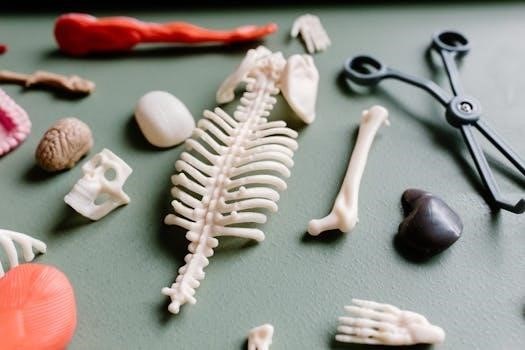
TEAS Math Practice Test PDF⁚ An Overview
The TEAS Math section is a crucial part of the exam, assessing mathematical skills necessary for healthcare professions. It includes varied question types, covering different concepts. Using a practice test PDF is beneficial for preparation, providing a realistic exam experience and helping identify areas needing improvement.
What is the TEAS Math Test?
The TEAS Math test is a section within the Test of Essential Academic Skills (TEAS) exam, designed to evaluate a student’s mathematical proficiency. This assessment is crucial for those seeking entry into various healthcare programs, including nursing. The math section focuses on core mathematical concepts and their application, ensuring candidates possess the necessary quantitative reasoning skills. It aims to gauge a student’s competency in areas such as numbers, algebra, measurements, and data interpretation. The test aims to assess a candidate’s ability to solve problems, analyze data, and apply mathematical knowledge to real-world scenarios. Successful performance on this section is often a prerequisite for admission into many healthcare programs, demonstrating a candidate’s readiness for the quantitative demands of their future studies and careers. It’s designed to be challenging, so preparation is key.
Key Content Areas of the TEAS Math Test
The TEAS Math test primarily evaluates candidates across two main content domains⁚ Numbers and Algebra, and Measurements and Data. The Numbers and Algebra section delves into a candidate’s understanding of numerical operations, fractions, percentages, ratios, and algebraic concepts. This encompasses solving equations, manipulating expressions, and applying these principles to problem-solving scenarios. The Measurements and Data section, on the other hand, focuses on a candidate’s ability to interpret data presented in various formats, like charts and graphs. It assesses understanding of different measurement units, conversions, and the ability to analyze data sets to draw conclusions. Questions in this area might involve calculations using measurements, interpreting statistical data, and applying these skills to different contexts. Mastery of these two areas is essential for a strong performance on the TEAS Math exam and a good foundation for healthcare studies.
Numbers and Algebra
The Numbers and Algebra section of the TEAS Math test focuses heavily on fundamental mathematical principles; Expect questions that assess your proficiency in performing various numerical operations, including addition, subtraction, multiplication, and division with whole numbers, fractions, decimals, and percentages. A strong understanding of ratios and proportions is also crucial, as is the ability to work with algebraic expressions and equations. This section requires you to solve for unknowns, manipulate algebraic terms, and apply these skills to practical problem-solving scenarios. Test takers should also be prepared to handle word problems that involve algebraic concepts. The ability to convert between percentages, decimals, and fractions is also tested, as is familiarity with mathematical properties and rules. This section is all about your core mathematical abilities and how well you can apply them in different contexts and within practical problems.
Measurements and Data
The Measurements and Data section of the TEAS Math test evaluates your ability to work with various units of measurement, interpret data, and apply these concepts in real-world situations. This section includes questions that involve converting between different units of length, weight, volume, and time, requiring you to be familiar with both the metric and imperial systems. Expect to see problems that use graphs, charts, and tables, requiring you to extract and analyze data to solve problems. You will need to calculate rates, averages, and other statistical measures from the provided data. Interpretation skills are paramount here, as you will need to draw conclusions and make informed decisions based on the information presented. This section also tests your understanding of basic geometry, including the ability to calculate areas and perimeters of common shapes. Practical applications of these mathematical skills within the context of measurement and data interpretation are key focuses.

Structure and Format of the TEAS Math Test
The TEAS Math section has a specific structure including a set number of questions, a time limit to complete them, and some pretest questions that do not count towards your final score.
Number of Questions on the Math Section
The math section of the TEAS exam typically consists of 38 questions. However, it’s important to note that not all of these questions contribute to your final score. Specifically, four of these questions are pretest items, meaning they are included for research purposes and do not impact your overall results. Therefore, while you will encounter 38 questions in total, only 34 of them are actually graded. These graded questions cover a range of mathematical concepts, including algebra, numbers, measurements, and data interpretation. It is crucial to approach all questions with the same level of seriousness, even though some might not affect the final score. Understanding this structure helps candidates allocate time effectively during the test, focusing on the questions that truly count towards their results; Knowing the exact number of scored questions is vital for pacing and strategy development.
Time Limit for the Math Section
The time allocated for the math section of the TEAS exam is 57 minutes. During this time, candidates must complete all 38 questions, including the four pretest questions which do not count towards the final score. Effective time management is crucial, as this limited time requires a strategic approach to tackling each problem. Students should aim to balance speed and accuracy, ensuring that they have enough time to attempt every question. Practicing with timed tests, like those found in practice test PDFs, is essential to develop a sense of pacing. It is important to avoid spending too much time on any single question. If a question proves too challenging, it is often beneficial to move on and return to it later if time permits. This strategy helps maximize the number of attempted questions and overall performance.
Presence of Pretest Questions
Within the 38 questions of the TEAS Math section, four are designated as pretest questions. These questions are included for statistical purposes and do not contribute to the examinee’s final score. The pretest questions are indistinguishable from the scored questions, meaning candidates will not know which questions are being used for research purposes. This design ensures that test-takers approach each question with equal effort. The inclusion of pretest questions is a standard practice in standardized testing, helping assessment developers to refine and improve the exam over time. Understanding that these questions are present can help reduce anxiety and allow test-takers to focus solely on performing their best on each question. It is not advisable to waste time trying to identify them. Focus on answering all questions to the best of your ability.

TEAS Math Practice Test Resources
Numerous resources are available, including free practice tests, online platforms, and study guides. These resources offer realistic questions and detailed explanations, aiding effective preparation for the TEAS Math section.
Free Practice Tests and Questions
Many websites offer free TEAS math practice tests and questions, providing a valuable resource for test preparation. These free resources often include questions that mimic the style and format of the actual TEAS exam, covering topics like numbers, algebra, measurements, and data interpretation. Some platforms provide diagnostic tests to assess your current skill level, helping you identify your strengths and weaknesses. Furthermore, access to free questions allows for consistent practice without any financial investment, making it an accessible study option. Several sources also offer detailed answer explanations, which are crucial for understanding the concepts behind each question and learning from mistakes. These free practice tests may be timed to simulate the exam environment, aiding in time management during the actual test. Remember to utilize these free resources effectively by incorporating them into your regular study plan, and review your answers carefully to maximize your learning. The variety of free practice material ensures you’re well-prepared for the different types of questions on the TEAS Math exam.
Online Practice Platforms
Numerous online platforms provide resources for TEAS math practice, offering a convenient and interactive way to prepare for the exam. These platforms typically feature a wide variety of practice questions, often mimicking the actual exam’s format and difficulty. Many online platforms provide timed tests, simulating the real exam environment and helping students improve their time management skills. These platforms often offer detailed performance reports, highlighting areas of strength and weakness, allowing you to focus your study efforts effectively. Some online practice resources feature interactive elements such as instant feedback, step-by-step solutions, and adaptive learning technologies, which personalize the learning experience and cater to your specific needs. They may also offer a large database of practice questions, ensuring that you have exposure to various problem types. Furthermore, some platforms provide access to study guides, flashcards, and other learning tools, which enrich your preparation. Utilizing these platforms allows for flexible learning, fitting your study time into your busy schedule and providing comprehensive practice for the TEAS Math section.

Strategies for TEAS Math Preparation
Effective preparation involves consistent practice, strategic time management, and targeted study. Identifying areas of weakness is crucial for focused improvement, ensuring success on the TEAS math section.
Importance of Regular Practice
Regular practice is paramount for success on the TEAS Math test. Consistent engagement with practice questions helps solidify understanding of key concepts and improves problem-solving speed and accuracy. The TEAS Math section covers a range of topics, including numbers, algebra, measurement, and data interpretation. Familiarizing yourself with the format and types of questions through regular practice is essential to reduce anxiety and build confidence. Furthermore, regular practice helps in identifying personal strengths and weaknesses, allowing for focused study efforts. Consistent practice also enhances recall and retention of formulas and strategies. Moreover, frequent practice allows examinees to gauge their progress and adjust study plans accordingly. By incorporating regular practice into your study routine, you are more likely to achieve a successful outcome on the TEAS Math test. The more you practice, the more comfortable you will be with the exam’s content and structure. Regular practice truly builds a strong foundation for success.
Time Management During Preparation
Effective time management is crucial during your TEAS Math test preparation. Allocating dedicated study time each day or week is a great way to manage time. Create a realistic study schedule that aligns with your goals and lifestyle. It’s important to break down your study sessions into manageable chunks to avoid burnout and to optimize learning. Prioritize topics based on your strengths and weaknesses. Devote more time to the areas where you need the most improvement, while maintaining your mastery of stronger topics. During practice sessions, set a timer to simulate real exam conditions, this will help you get used to the time constraints. Practice pacing yourself so that you can complete all the questions in the allotted time. Don’t forget to include breaks in your study sessions. Time management during preparation ensures that you cover all the necessary material. Good preparation is important for exam success. Effective time management is a very important skill.
Identifying Strengths and Weaknesses
Pinpointing your strengths and weaknesses is a vital step in your TEAS Math preparation. Start by taking practice tests to get an overall view of your performance. Analyze your results to see which content areas you excel in and where you struggle. Identify specific question types that consistently cause problems, and then identify the topics that you understand very well. This detailed analysis will help you focus your studies on areas needing improvement. Don’t neglect your strengths, though. Continue to practice those skills to maintain your proficiency and boost confidence. Utilize practice test reports to track your progress and monitor areas of improvement. Regular review of your performance will help you to identify areas you have worked on and improved. Understanding your academic profile ensures that your study time is used efficiently. This process helps create a personalized study plan that addresses your specific needs. By focusing on your weak areas you will be more successful in the test.


